1000 SPM base in Factorio: Space Age
The Factory must grow.
 Miloslav Homer
Miloslav Homer
Let's write about something else for once. Factorio is a game where you build factories.
You start the game by crashing your ship on a planet named Nauvis. The plan is simple - get home. Develop and deploy automation that processes Iron ore, Copper ore, Coal, Stone and Crude oil into science and more automation. The factorio crafting system is complex, I've explored it more in-depth in my Gleba jupyter notebook.
If you never saw Factorio before, you can craft assembly machines that can craft things for you. Feed them with inserters and belts to transfer the resources which you can mine using other machines you can craft. Power all of this with electricity you can get e.g. by burning coal and that's the gist of it.
You start with an empty world - every entity needs to be crafted and (intially) manually placed. The system you create is your own a no two factories are the same.
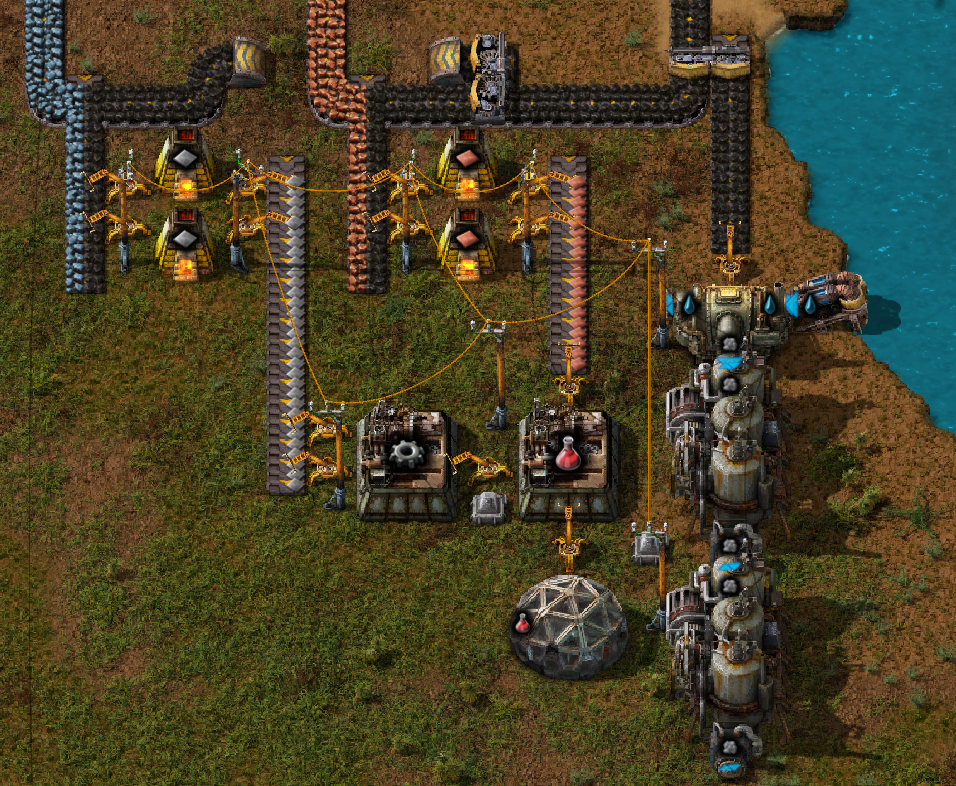
Unlock new technologies (by crafting science packs and using them in labs) and launch a rocket into space. That is the ending of the original game, but people wanted more1. The Space Age expansion builds upon that by unlocking custom space platforms and four new planets.
No wonder it's so popular amongst programmers and other IT types. The urge to automate is strong, and strongly encouraged. The feedback is immediate and it feels good seeing your contraptions working.
To me, the game is a miracle of engineering. The amount of entities you can process is truly something else. This encourages to build huge systems with high throughput. Among Factorio nerds, this is measured in produced science per minute (SPM). The old-school threshold for a megabase was at 1000SPM, so that was my target. Another goal was to finish the game and to reach the shattered planet. Here's my base. If you're confused, then please read on, I'll try and explain everything.
Nauvis
Nauvis is the vanilla factorio experience. You start with nothing, working your way up to more complex technologies. Unlock steam power, then solar, then nuclear. Unlock automation, logistics, trains. Discover oil, advance your science.
The native bugs (biters) push you into military research and defense automation. Your activities create pollution and they don't like it. Unlock walls, bullets, flamethrowers, tanks, lasers. Supply your walls with bullets. Upgrade your weapons and armour.
The name of the game here is expansion. Expand your smelting. Expand your power production. Expand mining. Then expand again. The factory must grow.
Then you'll unlock robots - simplifying some logistics and enabling automated construction. And a personal roboport for your power armour.
Finally, launch your first rocket. If you get this far, congratulations. You are able to tackle a complex problem, break it into small parts and systematically advance towards a solution. Yes, it does sound like programming and in a sense, it's exactly that.
Biter Wars
You'd need to expand into biter territory even in early game. Here's my strategy and tactics for these encounters.
Know your enemy - biters can only advance through land. They can't cross water, can't scale cliffs and can't jump over walls. Forests are not such obstacles.
To defend, we can set up a perimeter to keep the base in and biters out. Use terrain to your advantage, fill cliffs with walls. Chokepoints - areas where biters are forced to fight in a small place are the single most important concept. Set your defenses there.
Expand diligently. Identify new possible chokepoints you'd like to defend. Clear an area. Erect walls, start the defenses. Only then you can remove old defenses. The base should be within closed perimeter at all times. SET UP RADARS FOR FULL VISIBILITY!!! You need to see at all times if your new area is safe.
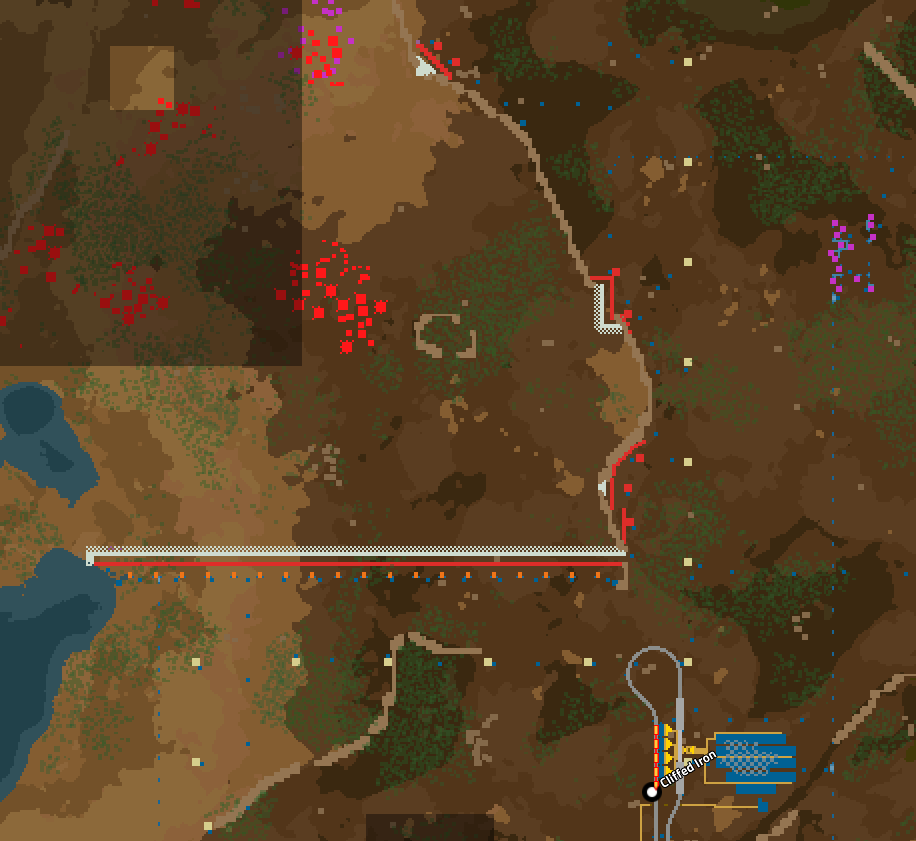
I'd recommend rushing to flamethrowers. They have cheap ammo and deal massive damage to groups of biters. If you want to be extra safe, set them more than 16 tiles behind walls to out-range spitters - I prefer to have the initial impact further from the walls. Supplement them with bullets/lasers.
Turrets should have their neighbours within range to add more resiliency in a case of a minor breach. Add bots to repair and rebuilt once available. A final trick that improves defenses are "dragon teeth" - bits of walls that break up a formation of biters.
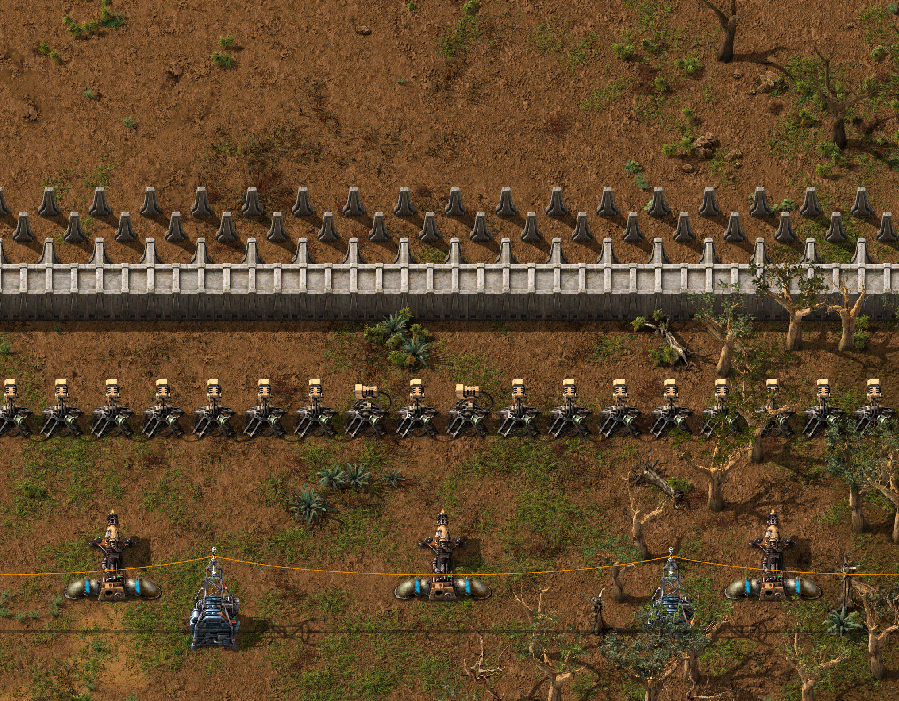
I'd recommend waiting for the tank to do a bigger expansion. Main cannon with shells is great against nests, built in flames are great against biters, you have bullets to fall back on. It's also a tank, so you have solid protection against hits. Keep moving, sometimes ram into worms. You can also throw grenades from the tank! Fun and efficient. Save often, one bad move and you're dead.
With each new military unlock, offense gets easier. Just be diligent and patient and you're set.
Nauvis Orbit
To get a hang on the space platform engineering, your first task is to process asteroids into space science. Don't worry, there are no big mean asteroids trying to destroy your platform, this is a safe space.
You still have to prepare all construction materials on the planet and ship them up to the platform. Hopefully your rocket production line is up to the task.
Pick Fleet
After many iterations and improvements, here's my space science station (blueprint). Some solar power (which is 200% more effective since there is no atmosphere loss), collectors around the platform that put the asteroids on a sushi belt2 and feed the science back to the hub. The circuitry near collectors is set to eject extra metallic and carbonic chunks. It sustains 300 SPM, plop five of them down for good measure, done.
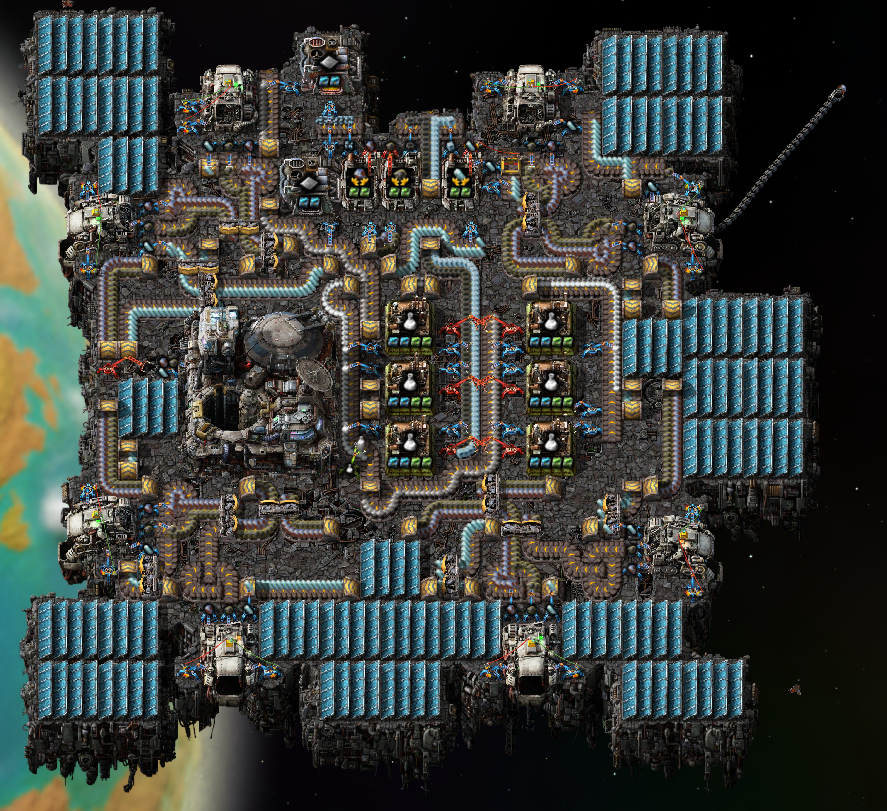
First Spaceship
As we need to colonize other planets, we need to figure out interplanetary travel. We need to construct a moving platform, which survives the barrage of asteroids. After some trial and error, I've arrived at this spaceship (blueprint).
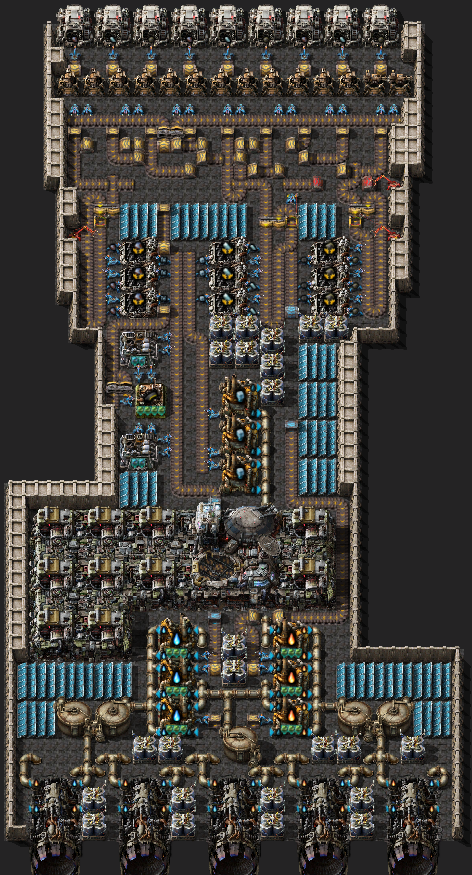
It's ugly, but it's fully self-sufficient (solar FTW) and it can handle the inner system (Nauvis, Vulcanus, Fulgora, Gleba). You process chunks into two types of thruster fuel and the rest of the iron into bullets. The walls are able to take a hit or two, but the defense is sufficient. Yes, it needs to rest between trips - to replenish fuel and bullets.
You'll notice that there are no chest buffers for those. That's because you can't construct chests in space. We'll get back to that later.
Now we can reach for the stars (err.. planets).
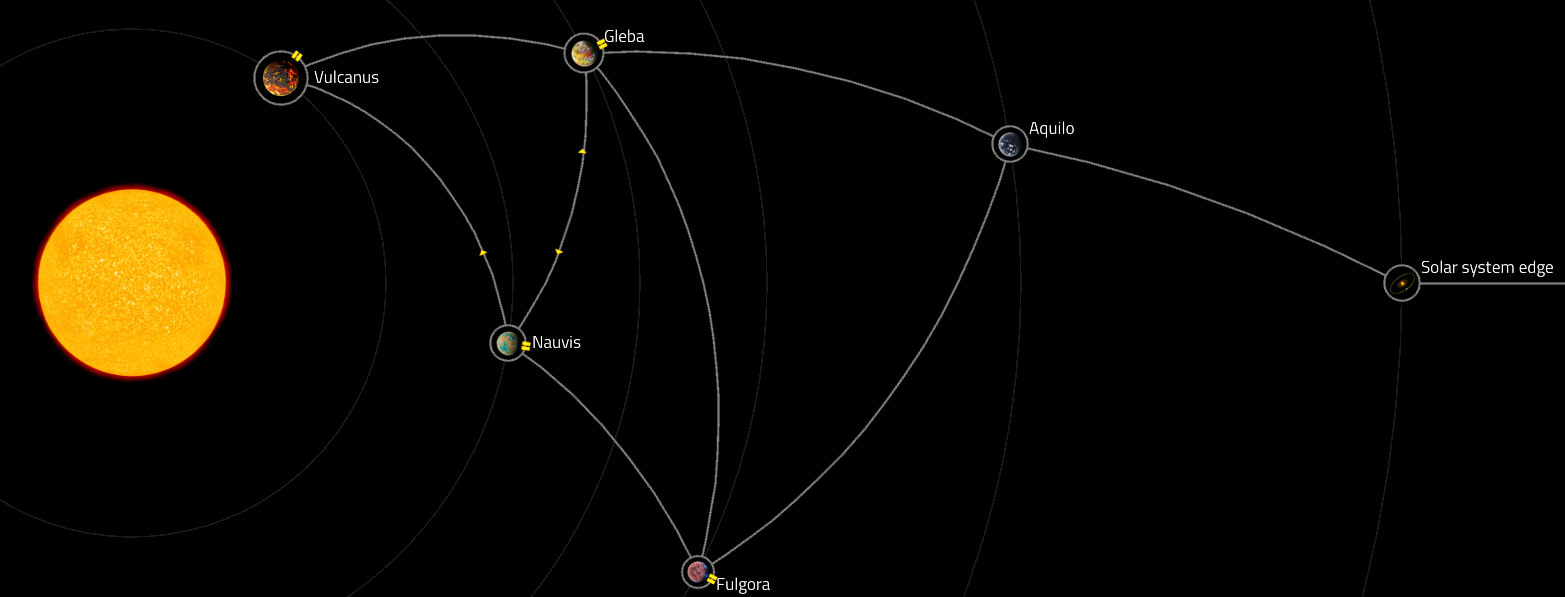
Vulcanus
Vulcanus is a high-pressure lava planet that is home to huge worms called demolishers.
This is the second planet I've visited3 but I really should have started here. You'll unlock foundries and big mining drills. These are ridiculously powerful. I am using them wherever I can. The worms are an inconvenience: you can use uranium tank shells to get rid of the small/medium ones, bring railgun for the big ones.
You'll get iron, copper and stone from lava and they are unlimited without caveats. Calcite and tungsten are this planet's unique4 resources - limited, but still plentiful. You have sulfuric acid geysers for unlimited H2SO4, which you can convert to steam with calcite (and then condense to water). The only missing piece is oil, which you can get from coal and then use water to get the rest of the products.
This was so simple to setup. Barely an inconvenience. I don't recall any issues at all. Solar works great. Recall that you get steam from H2SO4 geysers and calcite for practically free power. Dump trash to lava pools for instant evaporation. Go big.
Fulgora
Fulgora has no signs of life now, so you don't have to worry about that. There used to be an advanced civilization that left you piles upon piles of suspiciously compatible scrap.
Unlock the recycler to recycle scrap into various advanced intermediaries (plus concrete (for pedants)). You can also recycle nearly any item to a fraction of its ingredients. In a way, you're playing reverse factorio, getting back to raw materials from advanced products.
The other raw resource is unlimited heavy oil which you can pump using offshore pumps. Don't get too happy, you need to recycle scrap into ice into water to crack it down.
You'll get electricity from nightly lightning storms. Store the excess in enough accumulators and you're set.
There is a problem though - you don't have the space. All you get are tiny islands with weird shapes. Landfill won't help, you have to wait for foundation. Oh, and the big sources of scrap are on tiny islands. Good luck fitting both miners and trains on those.

Get all of that working and you're rewarded with electromagnetic plants with built in productivity and 5 module slots, overpowered Tesla weaponry and the cool mech armour that can fly over obstacles (and automatically detects incoming trains!!!).
Gleba
The issues with Gleba are plentiful:
- Most products spoil into spoilage, so your design needs to be tight.
- You need biochambers that are powered by nutrients, which also spoil.
- If anything chokes hard, you might find yourself without bacteria and pentapod eggs, needing a complex restart process5.
I could write a separate article on Gleba alone. And I did in this Jupyter Notebook. It figures out the rations of production needed to sustain required SPM. Enjoy the deep dive into Factorio crafting.
What do you get? Stack inserters, rocket turrets, plastic productivity bonus and advanced asteroid processing. Now you can access sulphur, copper and calcite in Spaace. That gives you all you need to craft explosives and rockets from asteroids, so now we can reach for Aquilo.
Intermezzo: Interplanetary Logistics
Before you attempt Aquilo, make sure you can:
- Get any item in the game on a space platform, so it can be delivered to Aquilo,
- Self-sufficient defense systems,
- Spare ore outposts connected,
- Excess of heat based power to ship (I've picked nuclear).
It will be a while before you can leave Aquilo - I'd recommend bringing all materials for a rocket silo and all materials for a rocket to handle emergencies. An Aquilo cold restart is easier than rebuilding Gleba because stompers wrecked your base.
Stick Fleet
This is also a great opportunity to establish an inner-system ship. Here's mine (blueprint):

- The advanced thruster fuel recipes are just so much better.
- For the inner system, yellow bullets are enough. Couple of laser turrets can handle anything that slips through (given enough damage upgrades).
- Since Oxide asteroids are quite rare, I've squeezed in a small reprocessing step.
- Speaking of oxide, I've inserted a cheeky circuit to detect calcite and ice to switch recipes when necessary.
- Don't forget to provide route for the excess chunks so that you don't choke on a type you don't need!
- Fill the rest with enough solar and accumulators to handle the Fulgora route, and we're set.
Brick Fleet
You'll also need an Aquilo-capable ship. Nuclear power is the obvious choice as solar efficiency drops sharply for the Aquilo route. All you need is water. Fortunately, the oxide asteroids providing ice are abundant on the Aquilo route.
We need to create rockets and therefore explosives. Fortunately, the advanced carbonic asteroid cracking produces the exact explosives ratio (1 sulfur + 5 carbon to 1 coal and another sulfur to explosives). As the ship will hang out in the Aquilo orbit, I've provided enough defenses on the whole perimeter.
So without further ado, here she is (blueprint):
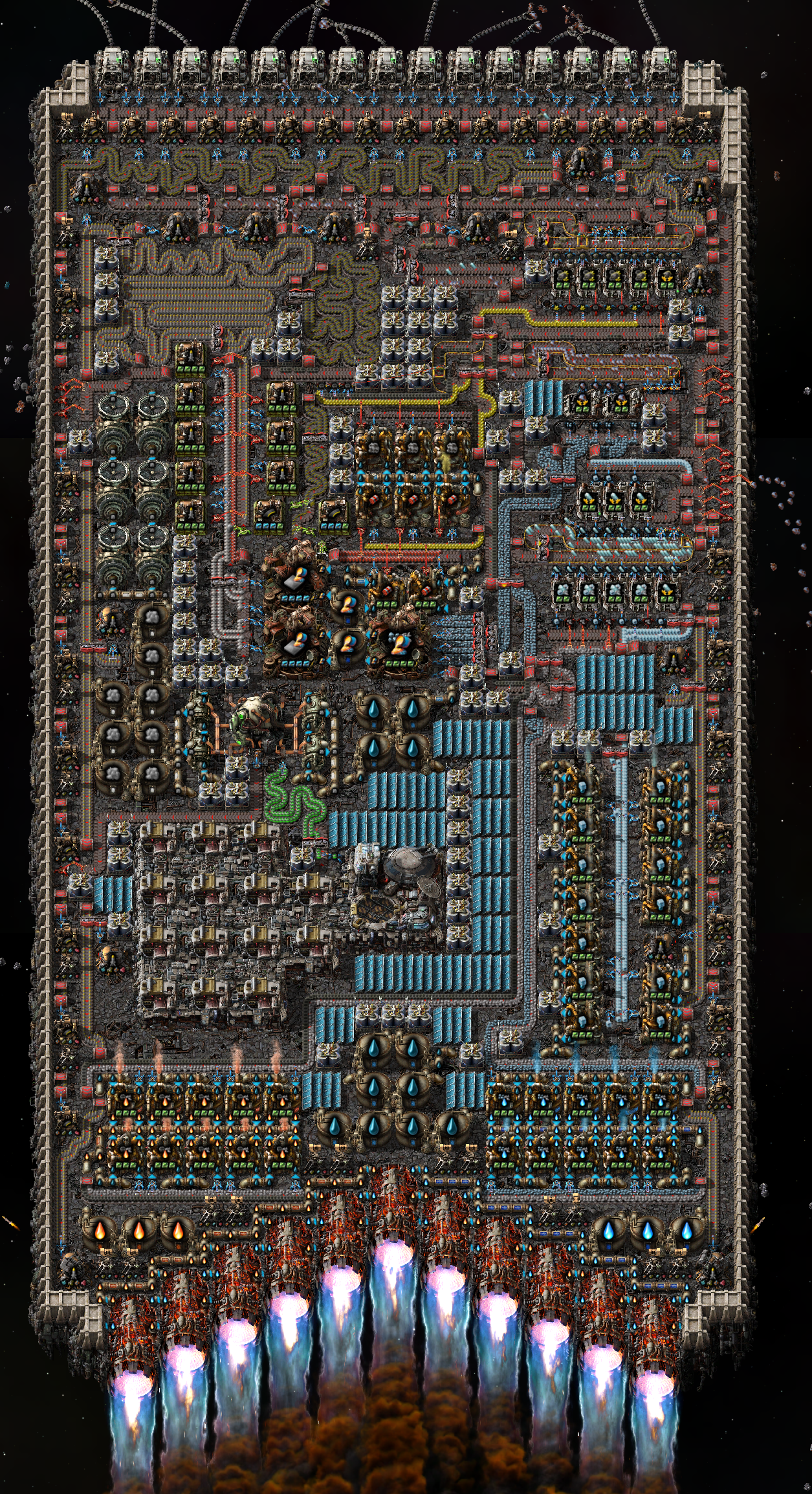
One final note, you might have noticed some extra belts twisting and turning. That's intentional. Since we don't have any chests for buffering, we can use a longer belt as a buffer.
Aquilo
Aquilo is the hidden MVP. You get Ammonium, Lithium, and Fluorine - critical resources for high tech assets. If there was no Aquilo, you wouldn't be able to leave this system.
This is the only planet where your buildings need heat supplied by heat pipes. I opted for nuclear source of heat, plop couple reactors down and you'll get so much heat for free with the neighbour bonus. Throw out your old blueprints, every small inserter and belt needs a connection. If you are thinking about bots, they are 75% less effective. Hope you like spaghetti6.
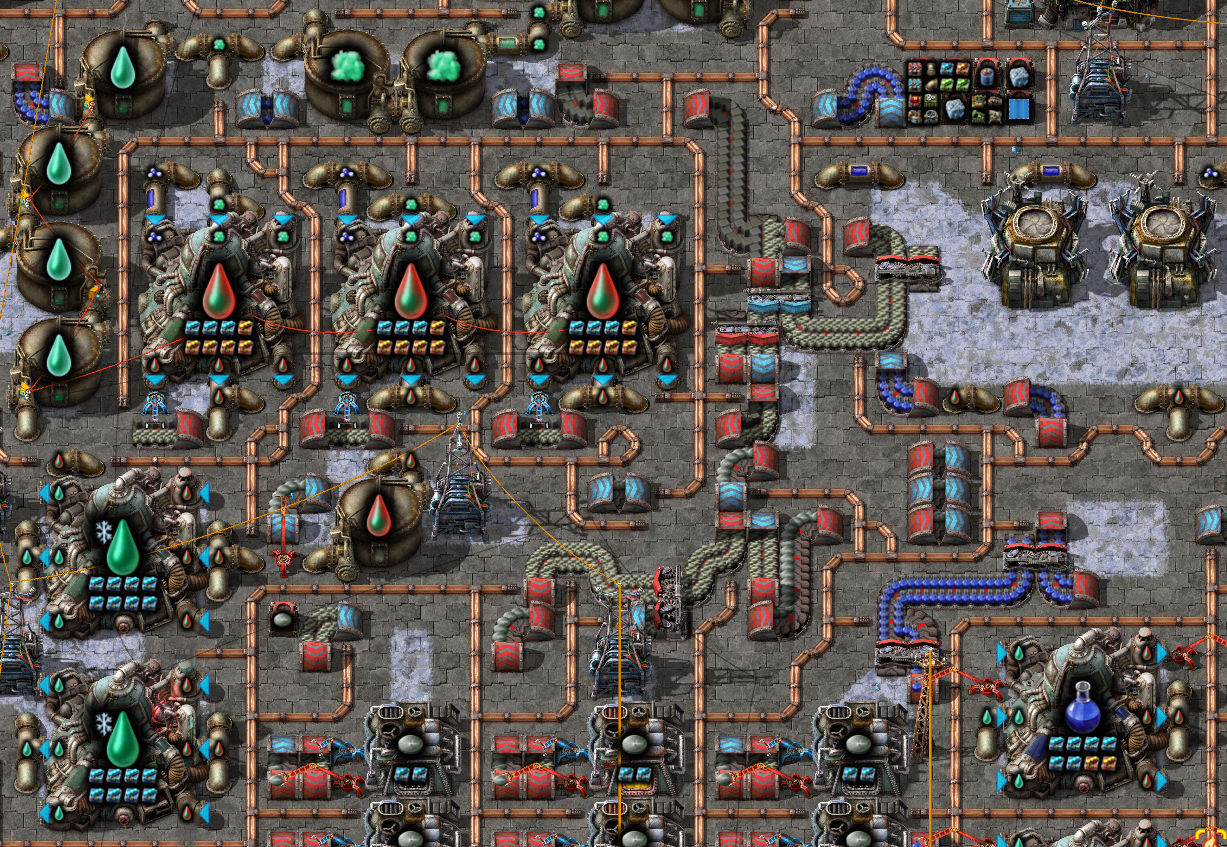
Separating ammonia from ice is a delicate balancing act. Choke too hard on amonia and you're out of water for the nuclear power. Lose power, now you can't refuel reactors and everything freezes. On the other hand, choke on water and the factory produces nothing. Ships are waiting for items to deliver, that means they are not fetching nuclear fuel. Again, everything freezes. You can't just trash the excess - recyclers don't process fluids. A literal cold restart is slow - the wait for the temperature to rise and propagate is long.
But here's a dirty trick for you - automated fluid disposal:
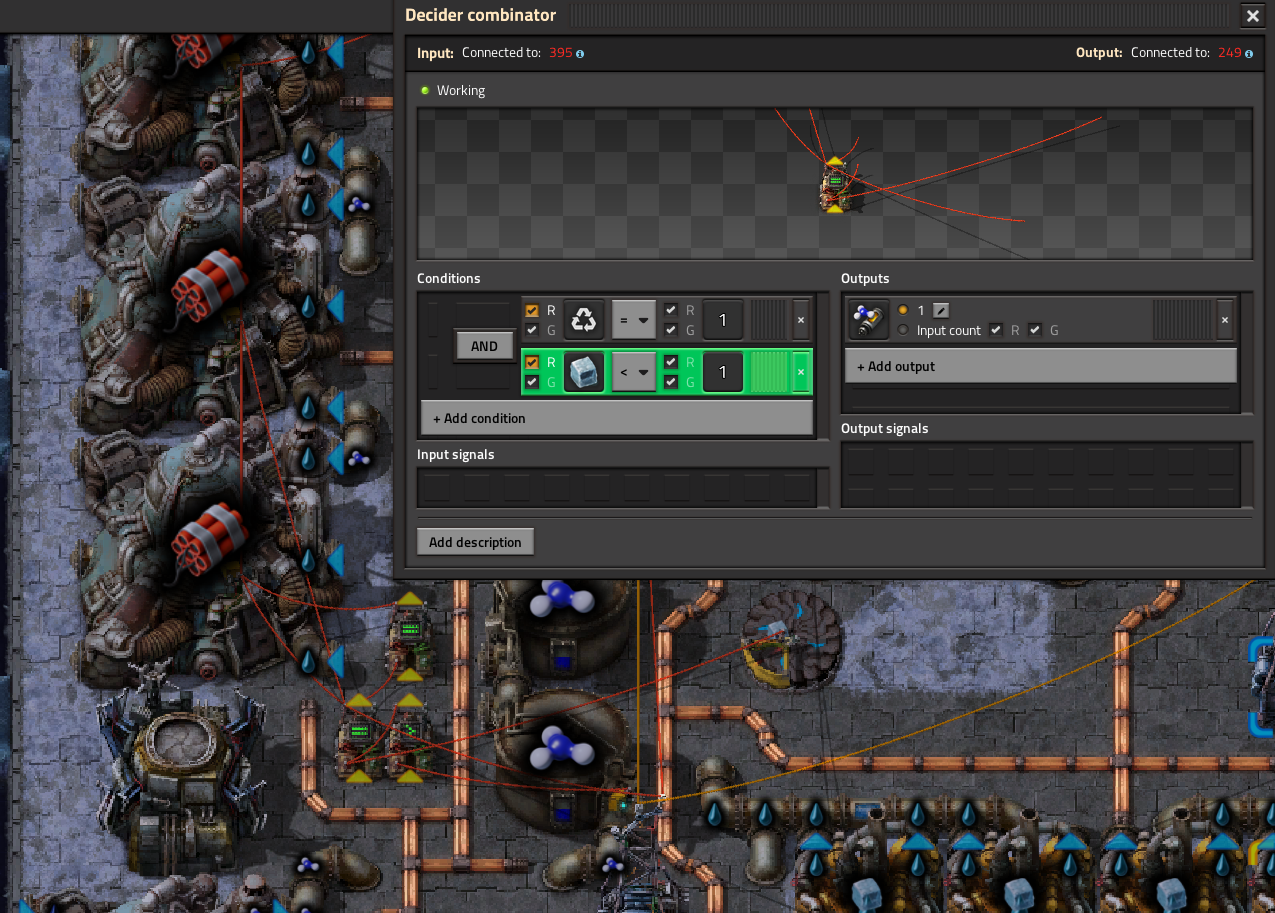
This uses an undocumented feature - say you have a recipe that uses fluids. The station loads the fluids inside. Then you decide to switch recipes. If the input fluids have nowhere to go, they disappear.
So the plan is to set up a timer (notice the single block of ice on 4 belts in a circle) to switch between two recipes - one that uses fluid we want to discard (ideally with the highest cost, like ammonia rocket fuel) and the other one that doesn't (explosives). Then we hook it up to a monitor of tank contents to decide when to activate switching.
After some time, I was trying to expand my Aquilo base and that included exploration for more resources. There was no reason to setup radars, so I went off flying:

I almost gave up at this point. Aquilo is concentrated depression. No sun, no life, no real pressure to do anything. Everything is kind of easy, but slow and tedious. You are alone on this planet and you feel it. I've realized how much time and effort I am putting to arranging pixels on a screen. I should be sleeping, there's no reason to be doing this at 1 am. It's definitely not fun - and what's the point then?
I don't know what to say. I went to sleep. The next day I was back for more. I have to do something, I won't let the factory eat me alive. I need to go through.
Finally, you unlock railguns, to split huge asteroids found beyond Aquilo and to bully demolishers. Unlock fusion power - a powerful, compact and simple energy source. Unlock foundations to finally fill Fulgora oceans and Vulcanus lava when required. Use Aquilo science to research rocket part productivity for cheaper rockets than ever. And boy, do we need rockets.
Beyond The Solar System: Promethium
To win the game, we need to reach the solar system edge. For that, we need a ship with railguns, to split the huge asteroids on the way beyond Aquilo. I've looked one step further.
The last resource you unlock is promethium. It's from asteroids beyond the system edge. This enables you to research research productivity, getting more science done per science pack. The issue is, they have a stack size of 1 and you don't really have plenty of storage on spaceships as you can't use chests and cargo bays are not space efficient. But you can buffer chunks on belts, provided enough belts.
Promethium science has another tricky component. Biter eggs spoil to big biters. Yes, they can hatch in vacuum and yes, they will eat your ship. I'll admit I didn't want to race with eggs to make promethium in outer space, so I opted for chunk storage and I processed science in Nauvis orbit.
Dick Fleet
We are getting into explicit hardcore Factorio, if you're squeamish (or under 18), I recommend skipping this section. You were warned.
I've dreamed about a strong, masculine ship, with hard head for penetration, extendable middle part to scale the storage and a soft nether region that will house the needed fluids. I looked into the nature for inspiration, realizing that the answer is literally within my grasp. I came to this design (blueprint (sadly, my ship is too big for the site to handle)):
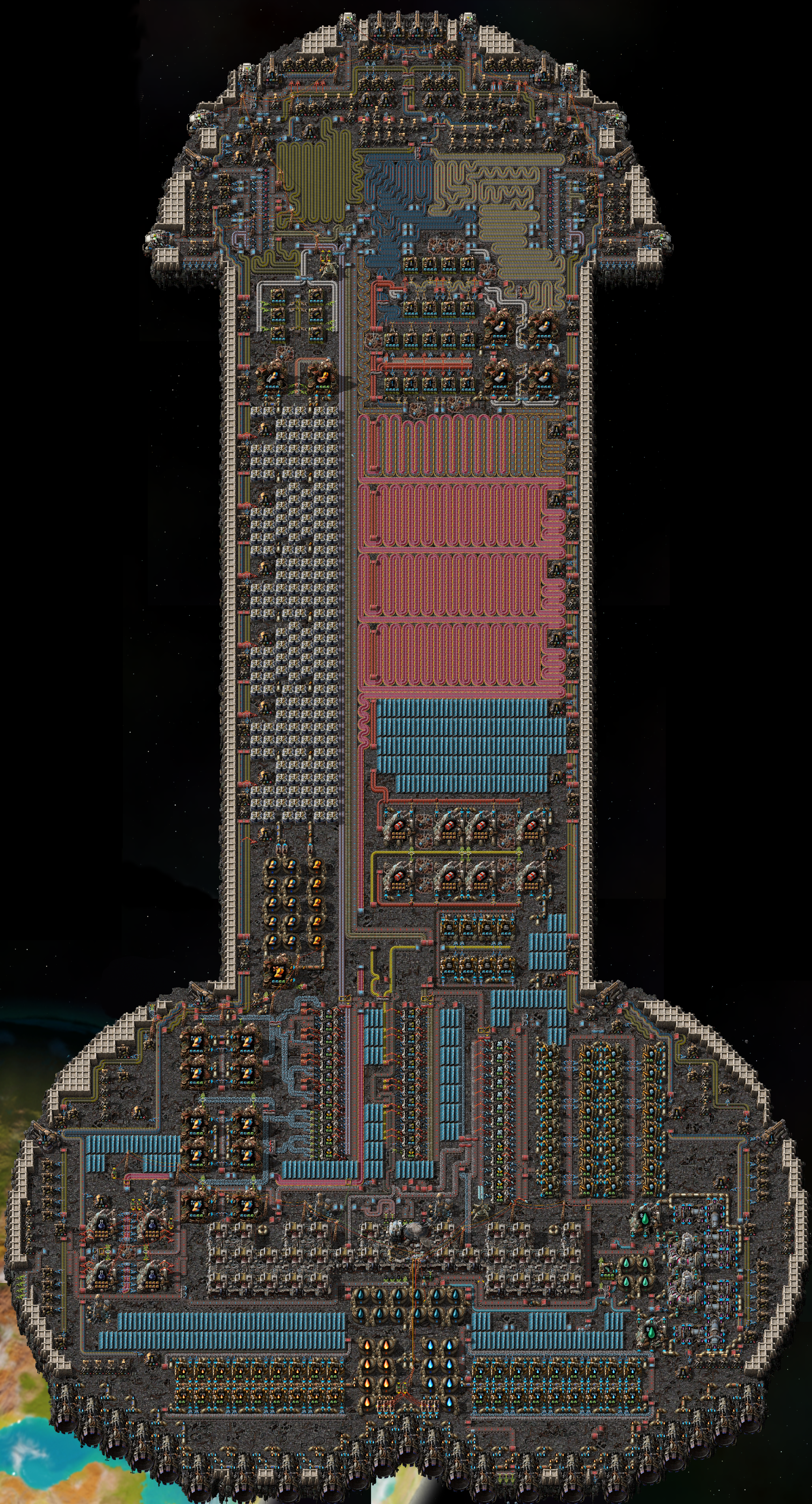
It takes time until all of the vital arteries are full, I wouldn't recommend penetrating the asteroids immediately. You also might be tempted to ram it full speed towards the shattered planet. This is ill-advised - not only it exhausts the ship prematurely, but the head is also quite sensitive, so any scratch hurts a lot. A simple circuit established a pleasant speed with small, rhythmic variations.
I can't stress enough not to forget at least a thin protective layer (of walls) all around the ship. It makes this activity that much safer and more enjoyable.
Of course, one ship cannot satisfy all my needs (for promethium). It takes approx 40 minutes to pump it up with chunks. Once it reaches Nauvis, it needs a bit more time and biter eggs to build-up promethium science. Any moment now it can release the science all over the labs.
The ship is big enough to store 12k promethium chunks. You might say bigger is better, and you can trivially extend the shaft, but it has downsides. For one, to collect more chunks you need to last longer out there, which isn't easy as the asteroid density increases. Counterintuitively, once you get used to bigger ships, you need to have more of them to satisfy your needs (for promethium).
I've found out that three of these at the same time is the maximum the base can handle. In the end the base was able to drain 5 ships, fortunately they've established a rotation, so that the egg production was enough.
First time I rode it, I was nervous and excited. As we went deeper (into space) it was clear that the ship will last. I was eagerly awaiting the climax of our journey and then it came - to the edge of the solar system. I did it, I won the game. And I had the privilege to join the Galaxy of Fame.
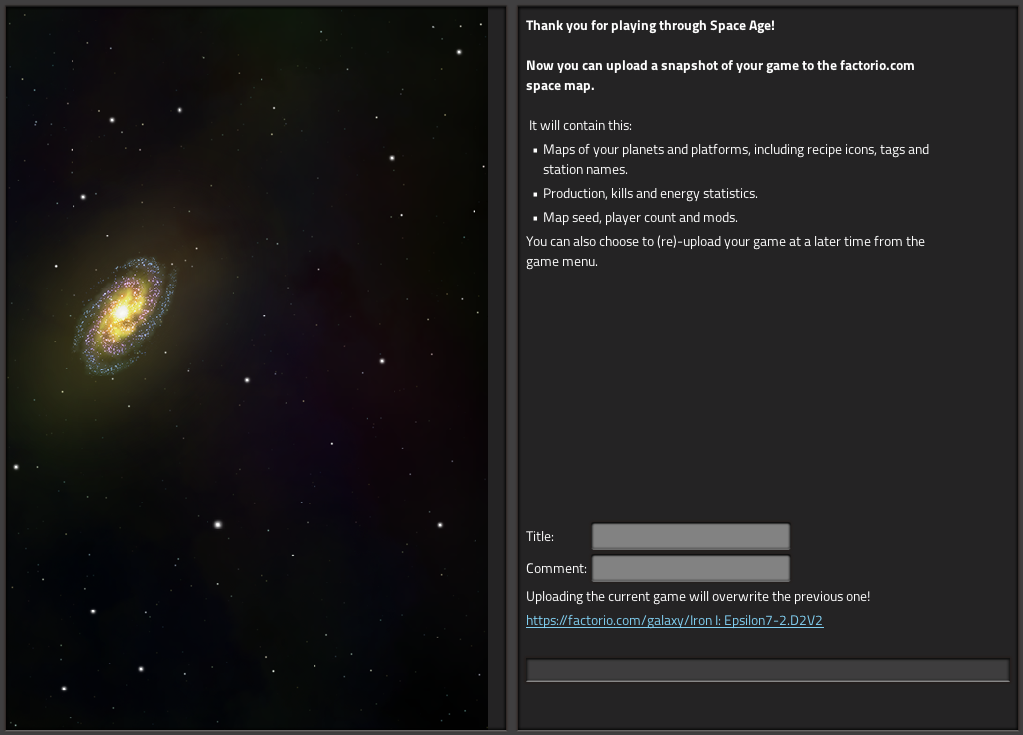
Megabasing
I didn't feel like I am done though. I thought I can do more, so here's my know how on how to build a megabase (1kSPM+).
Rate Calculations and Design
Factorio math seems easy. Set requirements and count the pre-requisites backwards. Work with rates, rather than product counts. It's tedious, but it works. As you'd learn in the Gleba worksheet, there are plenty gotchas.
Here's how I did it with an example. Say you wanted to make 10 red science per second. Setup one machine that you'd like to use with the intended modules. If you're not working with exotic materials, I'd recommend always using speed modules. The game will then tell you the rate of that one building, like so:

Ok, so this tells us we need 20 such buildings to produce 10 red science per second. These we need to supply with 20 gears per second and 20 copper plates per second - this can fit on one blue belt (45 it/s, so 22.5 it/s per side). Rinse and repeat, do the same for the gears and plates.
Nauvis Science
My requirements were 22.5 science per second. That compressed half of a blue belt, yields approx 1200SPM and makes for a nice biolab layout. Speaking of belts, watch out for the rates and layouts so that you have enough throughput of everything.
You can also note the symbols on the map, which then acts as a notepad for the design:
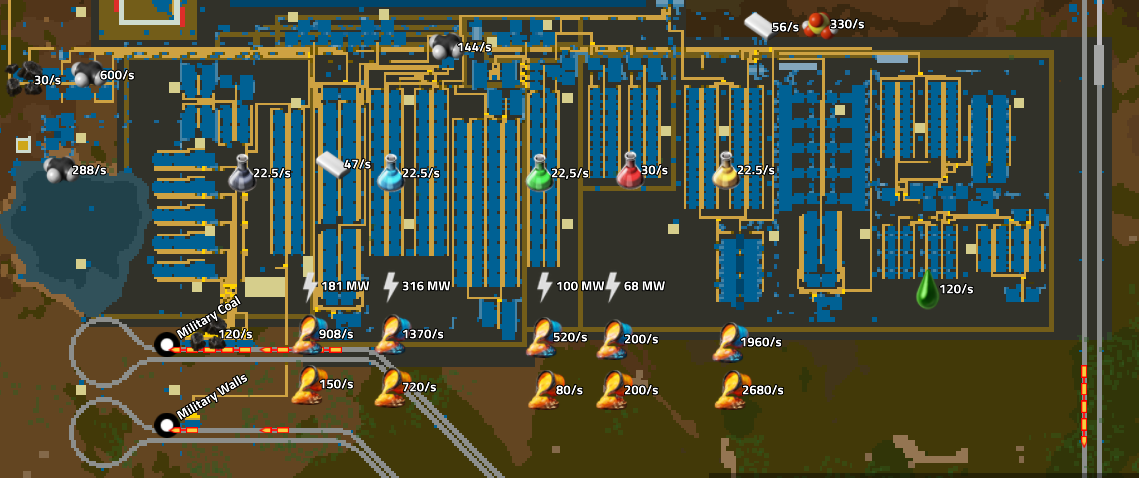
I've decided to import coal and walls for military science by train, because the coal patches are rich and because stone walls compress better into trains, so I made them on-site.
You'll reach absurd rates when you get back to the base resources like ore, stone and oil. That's the place to really invest in good scalable design. If you can, transfer fluids. The speed is instant and the pipes have unlimited throughput. If they are too long, you need to add pumps - add enough to hit your throughput target. That's why I stopped my process with molten iron and molten copper and then designed the foundry (blueprint).
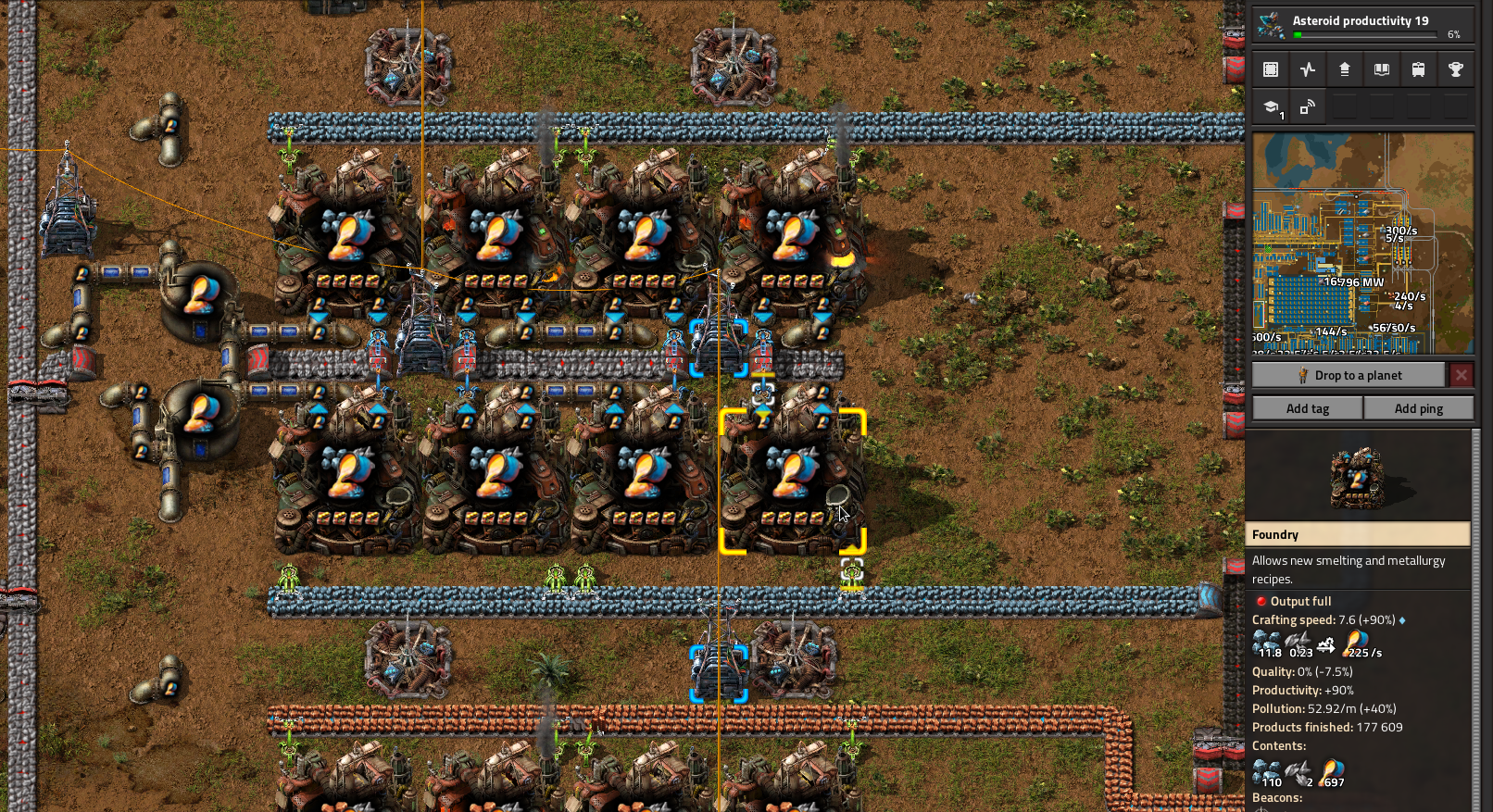
Trains
I recommend bringing the ore back home using trains. Here's my train advice, based on years in OpenTTD:
- If you can, separate the networks.
- Fix train length in a network (say 3 wagons).
- Set up single direction railways - you'll be building them in pairs (there and back).
- Fix the side you're driving on.
- Place signals so that your fixed train fits into one block.
- Intersections should be minimal, have chain signals on entry, normal signals on exit. Use elevated rails.
- Before a big station, add some waiting lines, where trains can stay an other lines where these waiting trains can be bypassed.
- Stations need splitters and buffers to increase throughput.

I wish I had more to say, but this was enough to not see any issues whatsoever. No deadlocks, good throughput, simple principles to follow. Of course, it would be more difficult if I had to 10x the factory... But then I'd bring most, if not all science production to Vulcanus, since you can get free iron, copper and stone from lava. If I tried a bit, I could synthesize coal in space orbit.
Tips and Tricks
I recommend to maximally abuse the new production buildings. Most of them have increased speed and a built-in productivity bonus. Even cryogenic chambers - the variability of 8 module slots is valuable.
To have calcite for foundries on Nauvis, I set up a space platform in orbit gathering it for free from oxide chunks. You need very little, you can also try and re-process the other chunks to increase production.

If you do all of this, you'll realize that you're limited by stone. Purple science absorbs absurd amounts of stone (military science is not much better). In the end, I moved purple to Vulcanus, where stone is a byproduct of lava processing and therefore free on large quantities.
Another tricky part was Fulgora. The ratios of scrap yields are off and I've opted to crack oil into sulfuric acid to make my own batteries in addition to scrap batteries. Research more scrap productivity and you can pretty much throw your old design out.
If you need efficient recycling on Fulgora (especially steel and concrete) try these two tricks. Craft steel chests from steel and recycle them to steel. You'll be burning steel much quicker. Same goes for concrete into hazard concrete and back.
A stable design
The megabase was working well, in the end the design was stable.
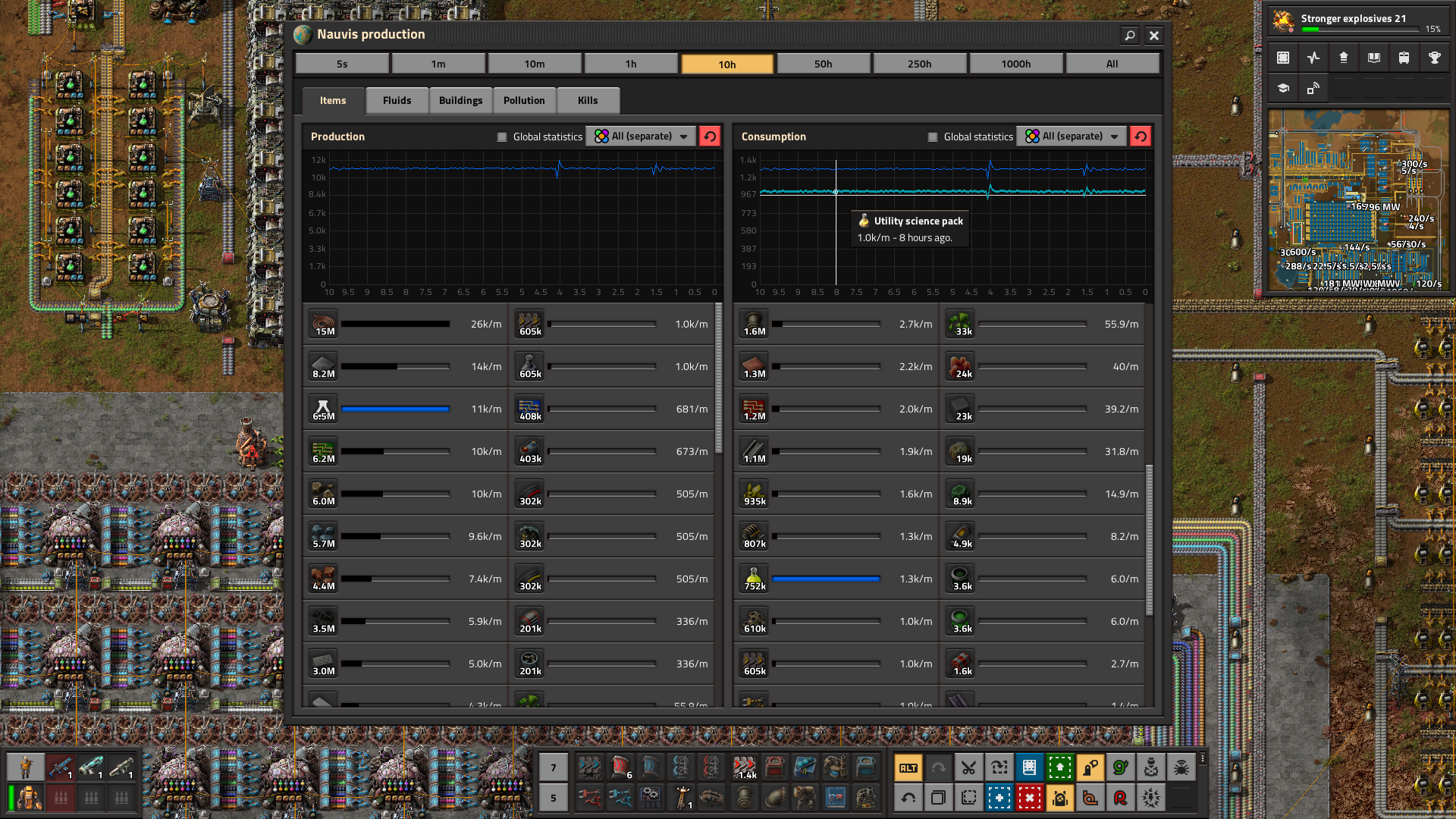
The limiting factor was Gleba science, because it spoils. With a better design I could have brought fresher science for better SPM. But I was happy with some slack, the target was 1k SPM and I hit it.
I still didn't feel done with the game for some reason, so I've started thinking: how to actually finish Factorio?
The Story
You might be asking: what story? But I think Factorio vagueness is open to plenty interesting interpretations.
The Horror Interpretations of the Story
First of all: environmental horror. During your playthrough, you exploit natural resources, pollute multiple planets and slaughter thousands (if not millions) of native life forms. If you're asking: so what? Then congratulations, you're the monster (confirmed by the devs).
Never are we stopped by the game to think if this is right, we can just march forward to our goal, destroying whatever is inconvenient at the moment. We gleefully deploy nuclear weapons, because our other overpowered weaponry isn't fast enough.
We don't stop there either. After performing enough experiments on pentapod eggs, we develop the ability to override the nervous system of biter nests to safely extract the biter eggs. Inserting these to enhance productivity modules is wrong, but the crowning achievement of this abuse is the utility of biter eggs mutated with uranium into a science processing monstrosity known as biolab.
I've forgotten all of these ethical issues as soon as I saw the 50% science pack drain which would double my SPM on the spot and I've built an assembly line chugging these abominations on an industrial scale.
All in the name of reaching our goal. We wanted to get home, remember? But did we? In the vanilla game, we've launched a rocket with a satellite. We didn't get home. In Space Age, you win if you reach the edge of the system. We didn't get home either.
If the shattered planet was our home, we're obviously done for. All we can hope for is to fill the rest of our days with tinkering and optimizing.
Of course, our factory will stop working at one point. Ore/scrap patches will run out, a ship might take a hit too large. Since Aquilo depends on other planets and an interplanetary logistic system, it will be the first to fall. Gleba has the potential to survive indefinitely, but a tiny inaccuracy in the system and it collapses. It's remarkable that we can't construct a self-sufficient system despite our best efforts. Entropy wins again.
The Hopeful Interpretations of the Story
If we crashed our ship (e.g. by shattering that planet) and our home is elsewhere, we have hope. Looking at the space map, the issue in getting home is the ridiculously dense asteroid field between the solar system edge and the shattered planet. You'll notice that the asteroid density falls down sharply near the 4Gm (yes, Giga meter) mark (side note, that's just 0.025 AU).

That means, we can get out of this. Then we have to come through, home to our family and never touch this game again.
Plenty of people didn't make the trip. The nickname Cracktorio was earned through the sheer addictiveness of this game. People get lost inside this world, losing months of their lives to expand and optimize the factory. In a way, they never returned home again - the factory has consumed them.
This interpretation is my own. Feel free to disagree. I am coming home though.
Travelling to Shattered Planet
To make this trip, we need to board a ship that gets us through the Shattered planet asteroid field. The space after that should be empty, so we can set it on autopilot and coast. We should also have some storage for asteroid chunks, just in case.
Railguns are strong, but the ammo production is slow. To have maximum efficiency, you need railgun damage 6 and railgun speed 10. No point upgrading beyond that, the speed is limited by the animation and the damage is enough for asteroids.
With such high density of asteroids, we need explosive rockets. These eat a lot of explosives, so we need a serious explosives production line. They are also slow to make, since we need to make normal rockets first.
Speaking of normal rockets, it's be great if they could one-shot big asteroids (two for promethium). That needs Stronger explosives lvl 23, which needs a whopping 65M science (approx 128M in total for all previous levels). It also helps with explosive rockets.
What we don't need is bullets. Laser dmg lvl 14 is more than enough to one-shot small asteroids and I suspect that explosive rockets would pulverize the rest anyway.
Final Ship: Nemo
Our ship should be thin. I've tried to do a "train-like" design, but the production refused to fit neatly into wagons. First class has got epic collectors though. And a lot of ammo production along with some storage and visual indicators.
The walls provide protection. Just throw all of the turrets there and spaghetti the asteroid collection later. They just repeat along the carriages.
The ship is so stupidly big, that I really struggled to showcase it. All of this material had to be carried to orbit. With almost 38k platforms and thousands of belts it took well over 2000 rocket launches to construct. Here's the scheme (and blueprint) alongside design calculations:

The head was quite simple - let's just fit as many railguns as comfortable, back it up with yellow rockets and then a barrage of explosive rockets should clean up the rest.
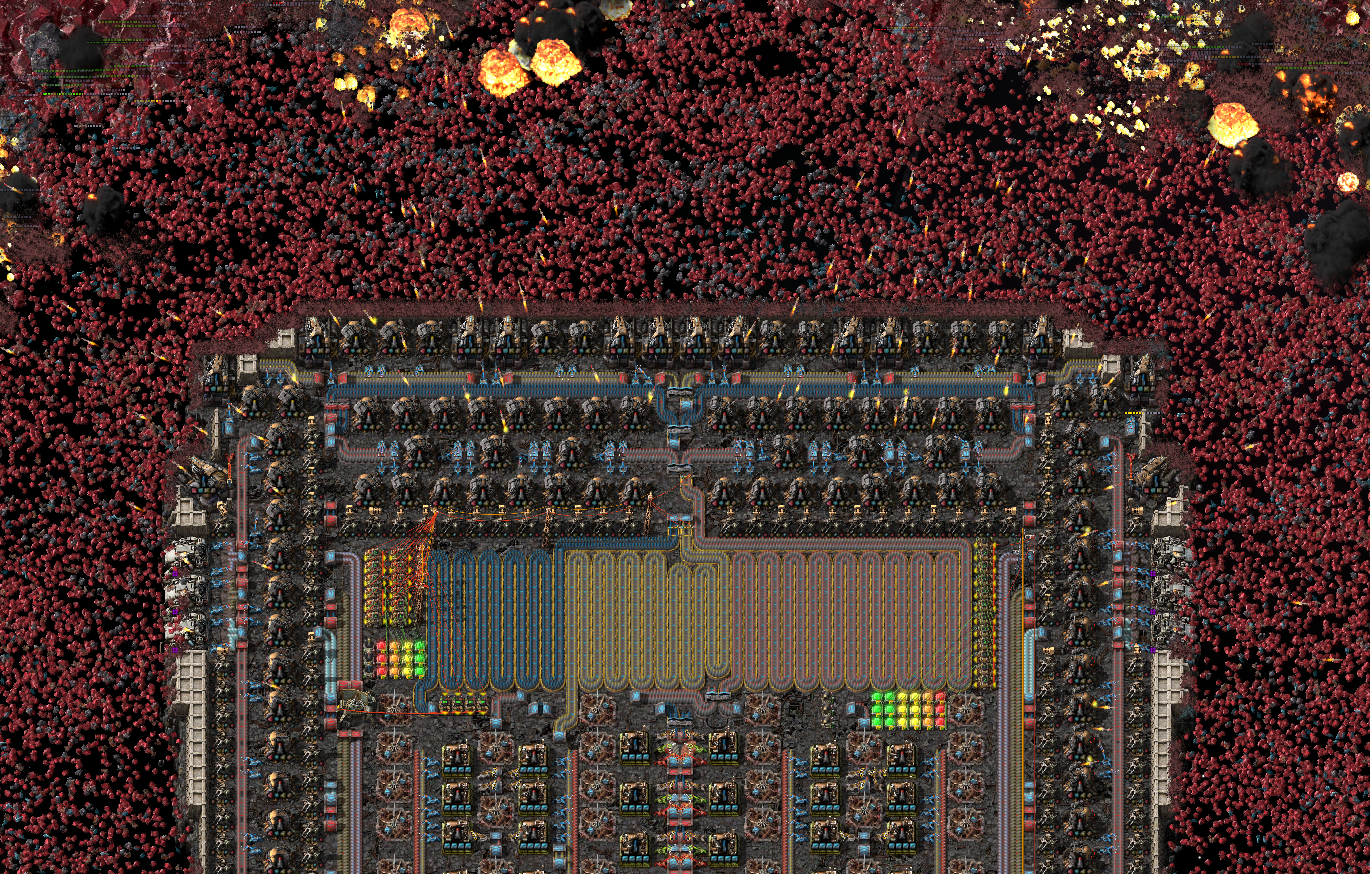
We need some serious ammo producing capacities, I've tried to fit as many beacons as I could + speed modules. Quality would help with compressing the design tremendously, but I didn't set it up and I didn't bother starting now.

Then we have power and storage, also with an on-ship platform factory and repair pack factory. It's not the prettiest, but I needed more than 6 cores and I didn't manage to fit 8.
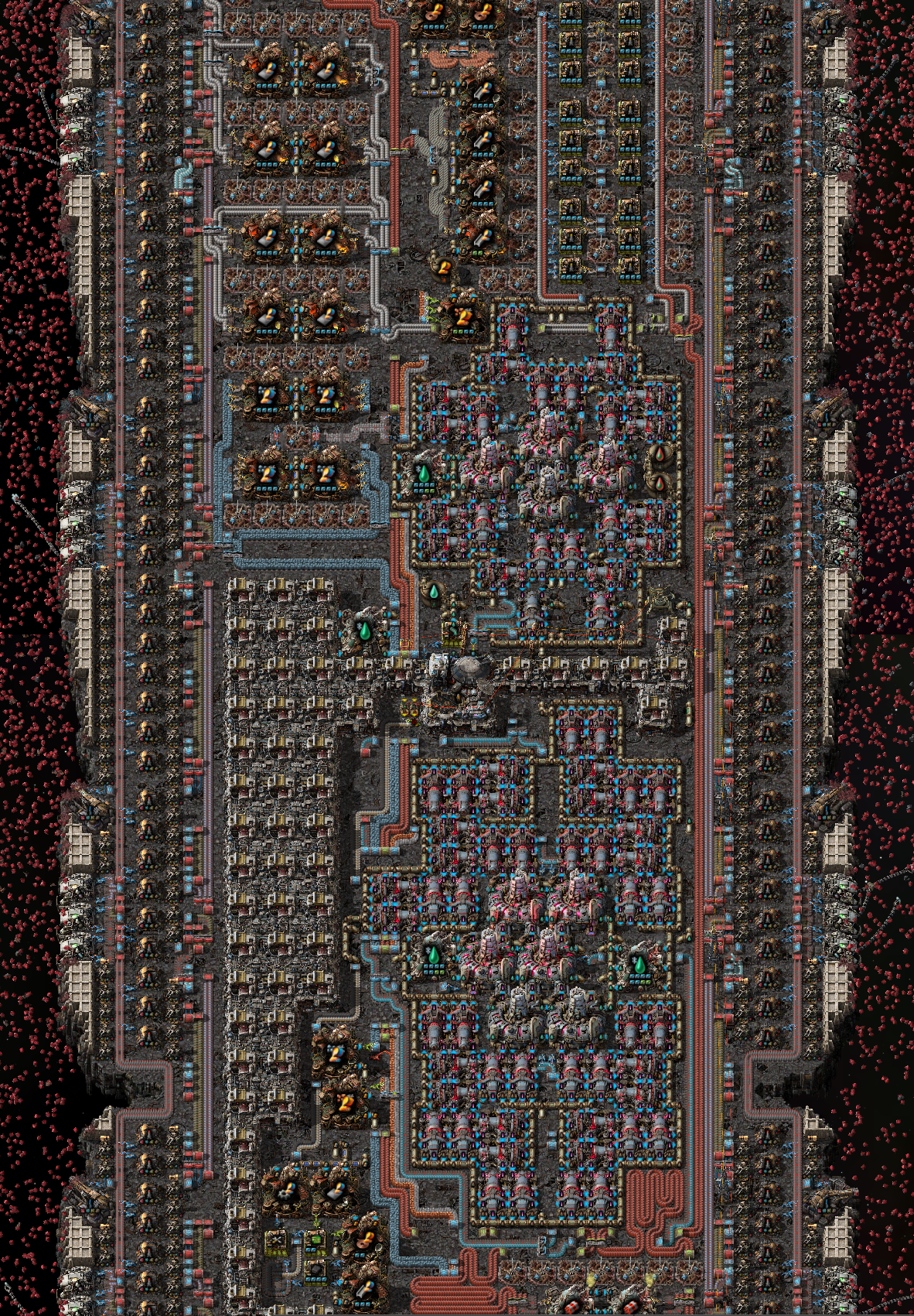
We need explosives and carbonic asteroid cracking. So much explosives. I was worried that we won't have enough chunks, so I went for productivity rather than speed.
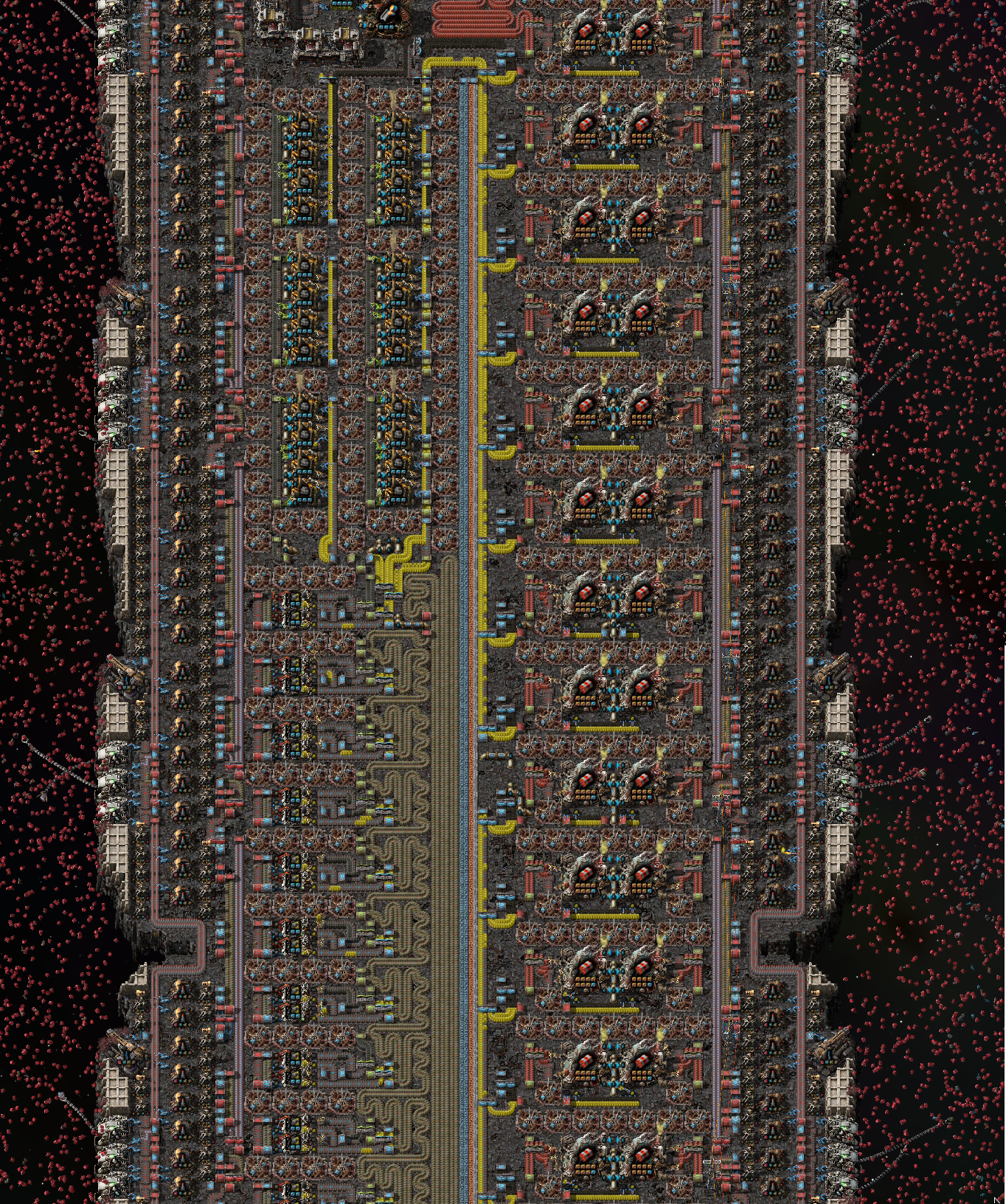
In the tail we got the rest of the cracking as well as asteroid reprocessing (we really need mainly carbonic chunks) and fuel production.
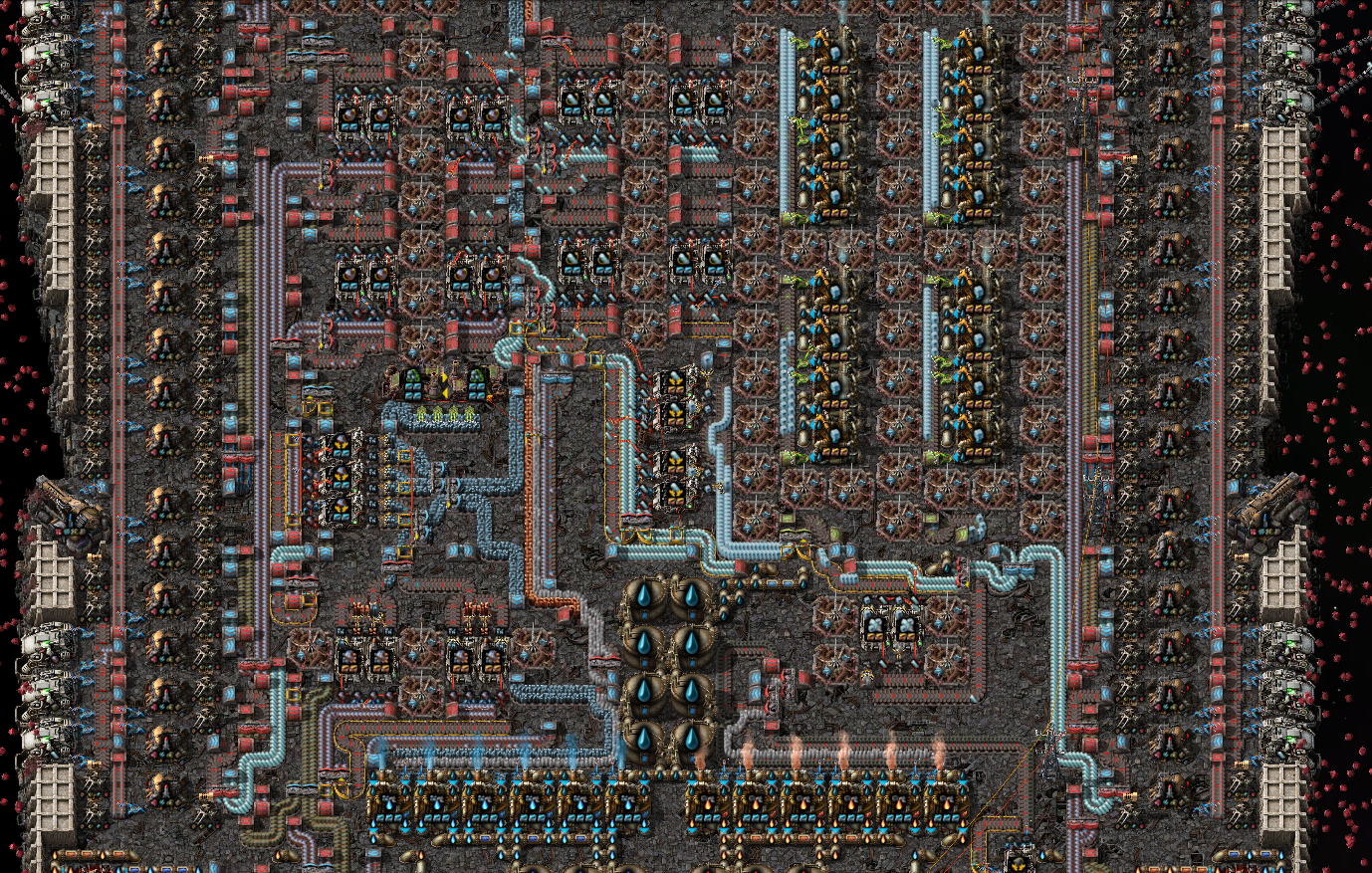
I am proud of the transmission. It watches for the current speed and if it's higher it turns the pumps off, which in turn reduces speed. It's simple, it works.
"Gear 1" is the minimum speed, for when other conditions fail. Gears 2 to 5 depend on the ammo - I've counted full belt contents and divided by four. Gear 6 is for any route that's not shattered planet. There's also a manual override, just in case.
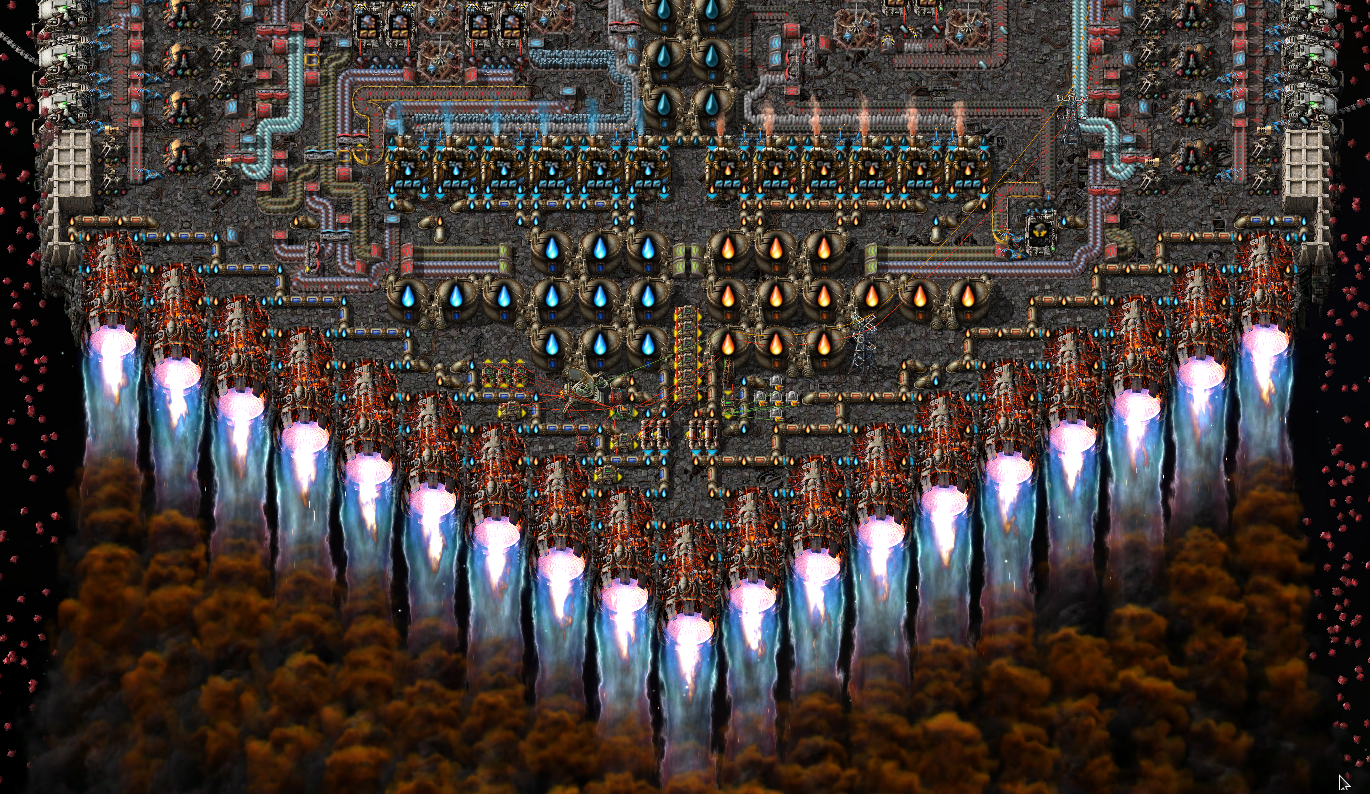
Megabase Operations
While we are preparing the ship, we got some researches to do and a base to keep online.
I am proud to say that the operations were mostly without incidents. I've quickly realized that stone outpost will need replacing on Nauvis, but the rest should hold. Big mining drills are awesome and mining productivity research cost scales linearly instead of exponentially. After some quick math I had all outposts established.
Since Gleba is organic, no outposts were needed. It was ridiculously stable. See for yourself (again, link to the worksheet):
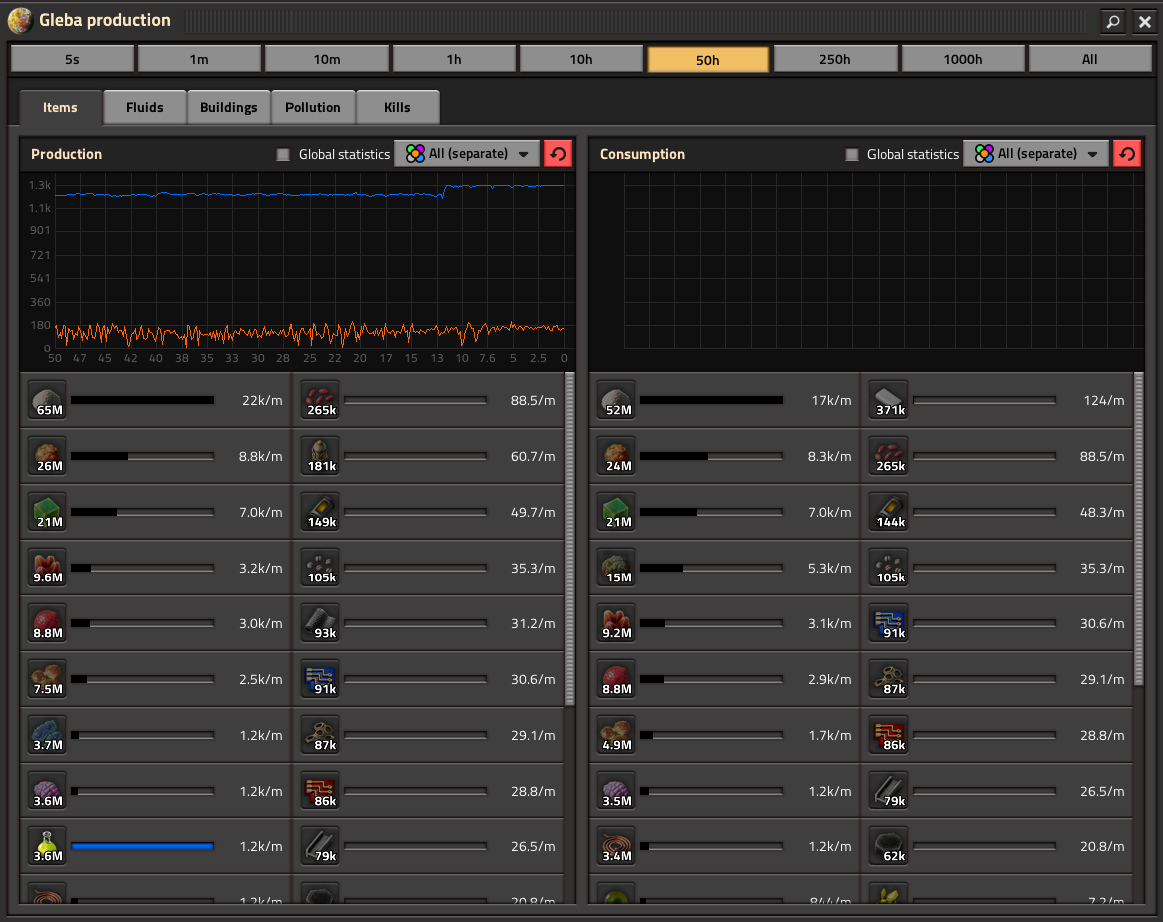
The first dip was about insufficient bacteria removal - they choked first and died out second. Then there was an instance of me trying to improve the design. Didn't help, didn't hurt. And the small but stable improvement was fixing the nutrient throughput to pentapod eggs.
As you can see, the researches I need mostly require Nauvis and Gleba. I estimated this would take me around 150 hours of playtime, which I don't have. With family and work, I can arrange 6 hours per week tops. This would take half a year.
Then I had an epiphany - my design is so good, I don't need to watch it full-time. Let it run, check in the morning, lunch and before bed. Do some touch-ups here and there. Suddenly, it only takes a week of real time - the game plays itself 24/7.
If you say that I should have expanded to higher SPM, let me tell you that I wouldn't be able to 100x the factory in couple hours. It would require kwality, which I've mostly managed to ignore (asteroid collectors being the sole exception). So this was by far the most efficient approach. And seeing the stability of my design is also very rewarding, especially since I didn't use any external blueprints (ok, I grabbed a couple belt balancers, I admit).

Driving Home
In the end I've got slightly impatient - I've bet on the base stability one last time and set off before Stronger explosives were finished. They should be done by 2Gm mark.
The first test is at 1.6Gm - huge asteroids have a local peak there, so our ammo production (especially railgun ammo) will be tested. This also nicely simulates the final stretch as we still two shot big asteroids with normal rockets and we will be two shotting big promethium asteroids in the end.
The noise is unbearable. We are literally drilling through solid rock. There are so many chunks. I can't hear the music anymore and my head hurts.
After seeing it worked, I've reduced the speed. I've calculated the speed needed for 7 hours of sleep, and went to bed, so that I could see the final stretch in the morning.
I am happy to report that the ship is over engineered and handily dispatched the asteroids. I could probably make it with 150km/s speed, but I went for a slow and steady approach.

I've done it. I am home.
Looking back on my 500h playthrough
I am stupidly proud of how I did this playthrough. I've accomplished all of my goals and I kept my job, my marriage and my sanity (to a certain degree at least). I've demonstrated to myself that I am able to setup a megabase with arbitrary SPM and that my real limits are playtime and UPS. The achieved rate of research is enough for all practical researching (looking at you, stronger explosives). That's assuming a stable design that can run without supervision (which mine was).
With that, I am content with not playing the game anymore. It's not healthy for me, the amount of sleep I've lost by "just fixing this one little thing" I can't count and I won't ever recover. It's high time I went outside and readjust to the sunlight.
If you, dear reader, I want to try this for yourself, be warned. This game is very addictive and takes a lot of time and brainpower. This particular playthrough took me just under 500 hours, with around 1500 hours spent in Factorio cumulatively.
I would do it again though. Thanks for reading.
Factorio has a beautiful relationship with mods. Devs actively encourage mods by exposing and maintaining a huge API. Even before Space Age there were mods expanding the base game (such as Pyanodons, Bobs, Angels, Krastorio to name a few). Moreover, Space Age took heavy inspiration from Space Exploration Mod, they even hired the mod author to work on Space Age!
A word of warning. These mods are not for the weak. Think hard if you're willing to commit thousands of hours into them.
Usually, you use belts to transfer up to one resource per side from point A to wherever you need. But there's another way. Have you ever been to a sushi belt restaurant? The idea is to insert many different items onto the belt and let the receivers separate what they need.
It's not easy to achieve optimal throughput with this approach. But if your requirements are somewhat low, the belt capacity can accommodate for such inefficiencies. The main advantages are that it's very simple to setup and it's space efficient (this is a huge benefit on space platforms).
I've started with Fulgora, because I wanted the Fulgora tesla weaponry and mech armour.
You can get calcite from oxide asteroid chunks once you have advanced asteroid processing.
Yes, you can stock up biochambers that you can recycle into live pentapod eggs. And yes, you can get bacteria from the fruits. Since my base was so stable I didn't bother automating this.
In Factorio speak, spaghetti means a specific belt layout, where it's so convoluted and intertwined that you really have no idea where one lane starts and ends. Not to be confused with spaghetti code, even though they both come from quick hacks and a lack of thinking.